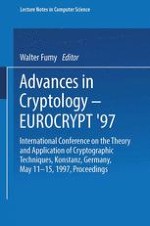EUROCRYEVr '97, the 15th annual EUROCRYPT conference on the theory and application of cryptographic techniques, was organized and sponsored by the International Association for Cryptologic Research (IACR). The IACR organizes two series of international conferences each year, the EUROCRYPT meeting in Europe and CRWTO in the United States. The history of EUROCRYFT started 15 years ago in Germany with the Burg Feuerstein Workshop (see Springer LNCS 149 for the proceedings). It was due to Thomas Beth's initiative and hard work that the 76 participants from 14 countries gathered in Burg Feuerstein for the first open meeting in Europe devoted to modem cryptography. I am proud to have been one of the participants and still fondly remember my first encounters with some of the celebrities in cryptography. Since those early days the conference has been held in a different location in Europe each year (Udine, Paris, Linz, Linkoping, Amsterdam, Davos, Houthalen, Aarhus, Brighton, Balantonfiired, Lofthus, Perugia, Saint-Malo, Saragossa) and it has enjoyed a steady growth, Since the second conference (Udine, 1983) the IACR has been involved, since the Paris meeting in 1984, the name EUROCRYPT has been used. For its 15th anniversary, EUROCRYPT finally returned to Germany. The scientific program for EUROCRYPT '97 was put together by a 18-member program committee whch considered 104 high-quality submissions. These proceedings contain the revised versions of the 34 papers that were accepted for presentation. In addition, there were two invited talks by Ernst Bovelander and by Gerhard Frey.
